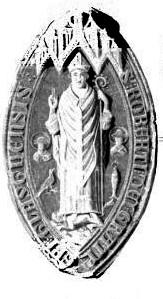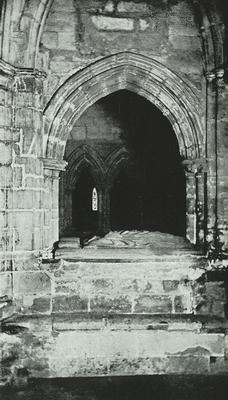Robert Wishart facts for kids
Quick facts for kids Robert Wishart |
|
|---|---|
| Bishop of Glasgow | |
 |
|
| Church | Roman Catholic Church |
| See | Diocese of Glasgow |
| In Office | 1271–1316 |
| Predecessor | William Wishart |
| Successor | Stephen de Dunnideer |
| Orders | |
| Consecration | 29 January 1273, at Aberdeen |
| Personal details | |
| Born | unknown unknown |
| Died | Probably 26 November 1316 |
| Previous post | Archdeacon of St Andrews & Archdeacon of Lothian |
Robert Wishart was a very important church leader, known as the Bishop of Glasgow. He lived during a time when Scotland was fighting for its freedom from England, called the Wars of Scottish Independence. Wishart strongly supported famous Scottish heroes like Sir William Wallace and King Robert the Bruce. For him and other church leaders, Scotland's freedom and the church's freedom were connected. His help was vital at many important moments.
Contents
Robert Wishart: Church Leader and Guardian
Robert Wishart came from the Wishart family. He was related to William Wishart, who was also a bishop and a former Chancellor of Scotland. Robert Wishart's first church job was as an archdeacon in St. Andrews. An archdeacon is a senior church official who helps the bishop. He became the Bishop of Glasgow in 1273.
Wishart was not just a churchman; he was also a key political figure. After King Alexander III died in 1286, Wishart became one of six Guardians of Scotland. These guardians were chosen to lead the country for the young queen, Margaret, Maid of Norway. They signed the Treaty of Birgham, which planned for Margaret to marry Prince Edward, the son of King Edward I of England. However, they made sure the treaty would not harm Scotland's independence.
Choosing a New King
Margaret, the young queen, died early in 1290. This left Scotland without a clear heir to the throne. The country faced the risk of a civil war between supporters of Robert Bruce, 5th Lord of Annandale and John Balliol. Wishart was involved in talks with King Edward I, who was asked to decide who should be king.
Edward I wanted to be recognized as the "Lord Paramount" (supreme ruler) of Scotland. Wishart bravely stated that "the kingdom of Scotland is not held in tribute or homage to anyone save God alone." Edward ignored these objections. Since Scotland had no way to settle the issue itself, Edward was accepted as overlord by the guardians and the people claiming the throne.
In a large court held in Berwick-upon-Tweed, Bruce and Balliol each chose 40 people to listen to their claims. Wishart supported Bruce. He continued to support Bruce even when some others voted for John Balliol, who had a stronger claim under the old laws. Wishart remained important during King John Balliol's reign. He was one of the leaders who approved the alliance between Scotland and France in 1296. This alliance later became known as the Auld Alliance. After Edward I conquered Scotland, Wishart and other Scottish leaders had to promise loyalty to the English king.
Fighting for Scotland's Freedom
Even though he had promised loyalty to Edward, Wishart quickly joined the fight against English rule. He, along with William Lamberton, the Bishop of St. Andrews, and David de Moravia, the Bishop of Moray, were strong supporters of William Wallace and Robert Bruce. They were patriots in two ways.
The Scottish church had always wanted to be independent within the wider Christian church. It resisted attempts by English archbishops to control it. Edward's conquest meant the Scottish church might have to answer to English church leaders. An old book, the Lanercost Chronicle, said that Wishart and other Scottish churchmen were "the cause of the people's ruin." It claimed they secretly encouraged nobles and common people to fight against the English king. They even said it was more right to attack the English than the Saracens (Muslims).
Wishart's Early Rebellion
In 1297, before William Wallace became famous, Wishart was already leading a rebellion against the English. The Lanercost Chronicle says that Wishart and James Stewart encouraged Wallace to act. Wishart's first rebellion ended quickly in July 1297 when he surrendered at Irvine. However, the fight for freedom had begun and would not stop.
Wishart was imprisoned for a short time. He promised loyalty to Edward again, but he broke that promise as soon as he was free. In 1301, King Edward wrote to Pope Boniface, asking for Wishart to be removed from his position as Bishop of Glasgow. The Pope did not agree to this. However, he wrote to Wishart, telling him to stop opposing Edward. The Pope called Wishart "the prime mover and instigator of all the tumult and dissension." In 1304, when many Scottish patriots surrendered, Wishart was sentenced to be exiled from Scotland for two or three years. This was "on account of the great evils he has caused."
The Bishop and Robert the Bruce
On February 10, 1306, Robert Bruce and his supporters killed John III Comyn, a main rival, in a church in Dumfries. This was a serious act of rebellion and a great sin in the eyes of the church. Bruce was now an outlaw and excommunicated (kicked out of the church). It would take many years for the Pope to forgive him. However, the support of Wishart and other Scottish bishops was incredibly important at this difficult time.
Bruce went to Glasgow to meet Wishart. The murder had happened in Wishart's church area. Instead of punishing Bruce, Wishart immediately forgave him. He urged his church members to support Bruce. Wishart then went with Bruce to Scone, where Scottish kings were crowned. They met other bishops and church leaders there. This suggests it was a well-planned event.
Less than seven weeks after the killing in Dumfries, Wishart and other important figures witnessed Robert Bruce being crowned King Robert I on March 25. Scotland immediately prepared for war. Wishart, despite his age, was at the forefront of these preparations. The timber that the English had given him to fix Glasgow Cathedral's bell tower was used to build siege engines. He even personally led the attack on Cupar Castle in Fife, acting "like a man of war," as the English later complained.
Imprisonment and Release
These hopes were soon crushed by an English army led by Aymer de Valence in the summer of 1306. Bruce was defeated at the Battle of Methven and forced into hiding. Wishart was captured at Cupar. He was taken south in chains and put in an English prison. He was saved from execution only because he was a church leader. King Edward was very happy to capture this "traitor and rebel." He wrote to the Pope in September, saying that Wishart was being held in close confinement.
Wishart remained in prison for the next eight years. He became blind during his time there. He was likely held in Wisbech Castle. He was not released until after King Robert's great victory at the Battle of Bannockburn. He was part of a prisoner exchange. Wishart returned to Scotland and lived out his life in peace. He died in Glasgow in November 1316. He is remembered as one of the most important figures in Scotland's fight for independence. He was a supporter and friend of Wallace and Bruce, and a constant opponent of English claims to Scotland.
Final Resting Place
After his death in 1316, Robert Wishart was buried in the crypt of Glasgow Cathedral. He had been the Bishop there for most of his life. His tomb has no writing on it, and the head of his statue was damaged at some point, probably during the Scottish Reformation.



